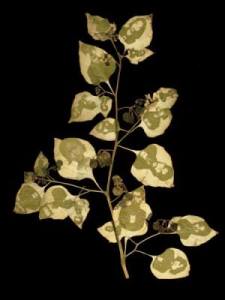Yesterday, I was told about Vietnamese-American artist Binh Danh, whose most recent exhibition, In the Eclipse of Angkor, includes a set of chlorophyll prints. What? I wondered as I read about him. An article reported that he invented this process of printmaking that involves photosynthesis. What? I wondered again. I learned that word before. Yes, the whole magic show that happens in plants that leads to the miracle of life and lush greenness (or whatever color it is).
Some of Danh’s leaf prints are of the prisoners of S-21 (also known as Tuol Sleng), a political prison established by the Khmer Rouge from 1977 to 1979. Upon arriving at the site in 1979, the Vietnamese, who had pushed the KR out of the capital, came across remnants, bodies, documents, and also, photos. These black and white mugshots are now currently on display in a room at Tuol Sleng, now a museum documenting the the events that took place on the site. The photos are one of the most well known symbols of the genocide.
Chlorophyll print by Binh Danh
The mugshots are familiar to me. I’ve looked over them so many times before. They are nameless and anonymous, marked by numbers and tagged. Most everyone wears dark or dull-colored clothing. The women and girls usually have short cropped hair. Many of these people have their hands tied behind their back. Most are expressionless and stare blankly. I remember one with a slight smile, or was it a smirk? Eyebrows are furled. Mouths are closed. Eyes are wearily opened. These photographs are industrial. They are sharp and harsh. They are lined in row upon row in an empty room, with white and mustard yellow-tiled floors. The sunlight that comes through the barred windows cast barred shadows on the photographs, and in this sense, says that the subjects of these photographs are still in prison.
In contrast to Tuol Sleng’s representation of the photographs, Danh’s leaves illustrate delicacy, tenderness, and fragility. Is it a subtle approach to a painful memory? There is something to say about growing the past in the form of a photograph with something that is living in the present time. Perhaps it is an urge to close the distance between the past and present and perhaps it is a statement that there is no difference between past and present.
Visit the artist’s site at http://www.binhdanh.com.

